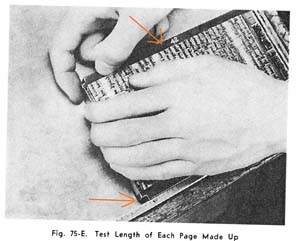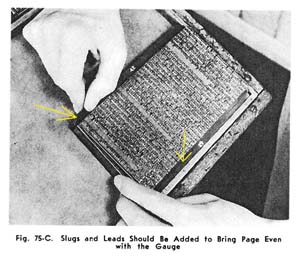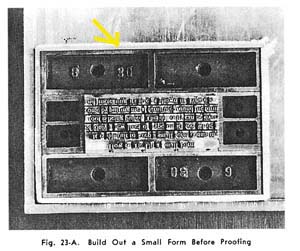What is a Page Gauge ?
I have a newbie question.
Page 98-99 of the General Printing book (by Cleeton-Pitkin-Cornwell, 3rd ed.), shows a “Page Gauge”. See uploaded images (Figure 75-C and 75-E).
What is a “page gauge” ?
Thanks.

page-gauge-1JPEG.jpg

page-gauge-2JPEG.jpg

page-gauge-3JPEG.jpg
n/a
Don’t get the idea that interlocking furniture is the same as page gauges. A page gauge is a length of material that is exactly the length of a standard page of a given job. All pages must be made up to the same depth for correct lockup and lift. They could be made of board, but the images show a piece of interlocking furniture, because the page depth is 42 picas, a length included in a font of interlocking furniture but not in standard furniture.
Thanks Parallel_imp.
Some more questions:
(a) Why would steel interlocking furniture reduce the total weight of the form? (don’t understand). I presume one needs 4 pieces of this steel furniture (top, bottom, left, right).
(b) Once the type has been locked-up inside this interlocking steel furniture, would you in turn lock the whole thing inside your chase (for platen presses) ?
Thanks.
The interlocking steel furniture is indeed heavy, but four pieces put together in the middle of a form would be lighter than the corresponding pieces of steel furniture of a more solid nature. Think large forms and a space of 40x50 picas, for instance, and how much standard steel furniture would be required to fill that space. The furniture is not designed to surround a form, but rather to fill open spaces in a form.
Again, the interlocking pieces shown above are only for measuring page length during page makeup, they would not part of the lockup.
The interlocking furniture is used to fill out a given blank area; it isn’t used as a page frame (those exist, but are different). When filling out blank areas, the fewer pieces the better. One answer is Mammoth furniture (anything wider than 10 pica) and interlock is another.
There are several different kinds of interlocking furniture, The Morgan & Wilcox shown above are either two or three picas wide (the fonts I have increase in length in two pica increments, and I have some pieces 15 and 20 inches long), and the Challenge are a very heavy duty ten picas wide (in five pica length increments up to 60). Blanking out a 40 x 60 pica area with M&W furniture would weight a lot less than the same area filled with regular metal furniture, and the Challenge furniture not as much saving.
One of the real advantages of the M&W interlock is that you can blank out irregular areas, say 43 x 67, by choosing the right pieces and fitting the corners correctly (but with Challenge you can only go to 5 pica increments, like 45 x 65). With such a bastard measurement, it would take many separate pieces with regular furniture, but still just four with interlock.
Newbee Press, just as the book states, Notched metal furniture makes a good page guage. Skeleton or Notched metal furniture saves weight by creating an interlocking frame with an open center thus saving the weight. Your not supposed to lock up type in it, but I guess your could,it would be redundant to do so and possibly aggrevating. Metal furniture is more stable than wood and it makes a better page guage because of that quality.When I would print books with many pages I would crontrol “creep” with
1,2,3 point leading in between the metal furniture.
n/a
n/a
Thank you all for answers and guidance. Really appreciate it.
(a) Does anyone have any photos of interlocking furniture on Flickr (ie. what does it look like).
(b) Also, where can I buy these interlocking steel furnitures?
(c) I’ve uploaded a new image above (Figure 23-A). Is that a special kind of chase?
Thanks.
n/a
I remember seeing a trick using interlocking iron furniture to create an open slot in the locked-up form, holding a spring galley clip under tension so that a slug of Linotype material could be popped in, an impression or two pulled, and then replaced by another slug without pulling the form and unlocking.
Brian
Thanks Paul and Brian. I’ll check eBay and also google/bing it.
Thanks again.
Devils Tail Pess
That article was interesting. Sometimes I have the opposite problem. Being so used to thinking in points and picas it gets interesting when someone in offset or engraving dept’s. is talking inches. Glad that our line guages have both measurements. Ron
Speaking of line gauges (or pica poles), they are a basic printer’s tool and are especially important in page makeup. With a good line gauge, one that has fine markings and a measure in two-point increments, you can quickly determine page consistancy without making a special page gauge.
Gaebel’s line gauges have varied in terms of fine markings recently, but I have seen line gauges from Pacific Arc that are equal to Gaebel’s best, in 12”, 18” and 24”. Anyone using some quaint old brass Rouse gauge really should upgrade.
Those of you using digital prepress should know that traditional printer’s points are not exactly 72 per inch, and if that is what your software has in its preferences, a line gauge won’t match. But there are Schaedler rules that have either printer’s points or DTP points.
Thanks Parallel_imp, I didn’t realize there was a discrepancy between the point system on the computer and in letterpress.
I will be getting a line gauge (seems easier than page gauge).
Thanks.
For what it’s worth, here is a shot of several different types of interlocking furniture. The small pieces in the center show how 10 pica sections can be arranged into 10x12 or 11x11.
interlocking_furniture.jpg
Wow! thanks so very much Parallel imp. Very helpful photo, as I’ve never seen these before.